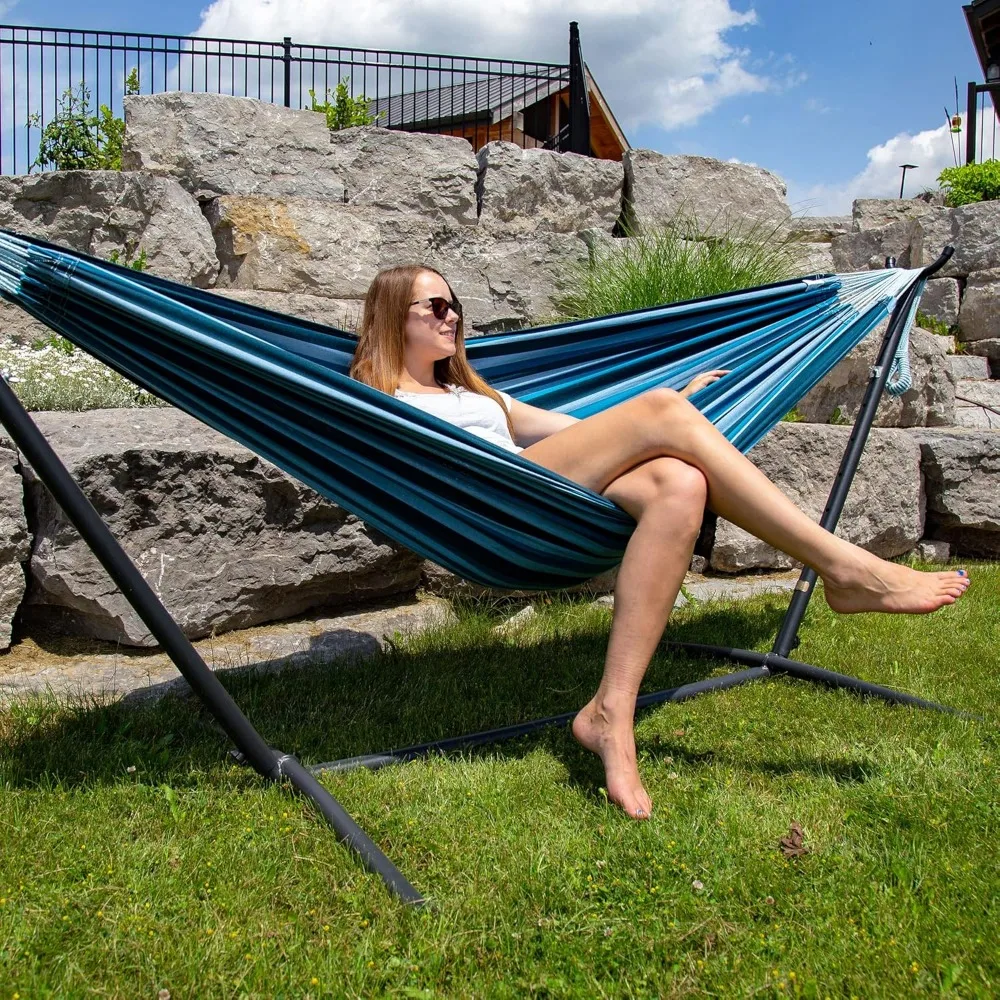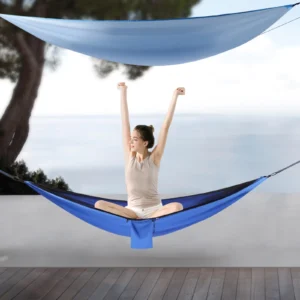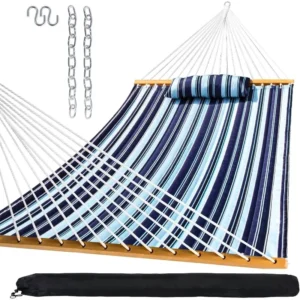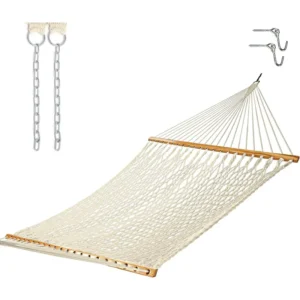The Science and Benefits of a Comfortable Hammock Setup
There’s much more to hammock comfort than simply hanging a piece of fabric between two points. When properly set up, a hammock can provide one of the most ergonomic and relaxing experiences available—even surpassing traditional mattresses for some people.
Research has shown that the gentle rocking motion of hammocks can actually promote deeper relaxation and better sleep quality. Sleep studies have demonstrated that this rocking movement can increase slow brain wave oscillations during sleep, helping you fall asleep faster and achieve more restorative rest.
The benefits of a properly configured hammock setup extend far beyond basic relaxation:
- Improved spinal alignment when positioned correctly
- Reduced pressure points compared to flat mattresses
- Enhanced sleep quality with proper positioning
- Natural stress reduction from the gentle swaying motion
- Better circulation when elevated properly
Many hammock users make critical mistakes that lead to discomfort—hanging too tight, creating a banana shape that forces your body into unnatural positions, or neglecting essential accessories for temperature control. Proper indoor-outdoor hammock placement significantly impacts how comfortable your experience will be, affecting everything from temperature to ergonomics.
This guide will walk you through every aspect of creating the most comfortable hammock setup possible, from selecting the right hammock to mastering hanging techniques and adding comfort-enhancing accessories.
Choosing the Perfect Hammock for Maximum Comfort
Types of Hammocks and Their Comfort Profiles
The foundation of any comfortable hammock experience begins with selecting the right style. Each hammock design offers distinct comfort characteristics that suit different preferences and uses.
Gathered-end hammocks bunch fabric together at each end, creating a cocoon-like wrap that many find exceptionally comfortable for sleeping. These allow for a diagonal lay (more on this later) that creates a remarkably flat surface without pressure points.
Bridge hammocks use spreader bars at the head and foot but maintain a sag in the middle. This design offers a flatter lay without requiring diagonal positioning, making them excellent for those who prefer sleeping straight.
Spreader bar hammocks feature the classic backyard look with wooden or metal bars that keep the fabric taut. While these provide easier entry and exit and excellent lounging positions, they can be less stable and less ideal for overnight sleeping.
Understanding the differences between most comfortable hammock types helps you choose the right foundation for your perfect setup. For those who value stability and easy entry, spreader bar hammock sets offer excellent options for casual relaxation.
Finding Your Ideal Hammock Dimensions
Hammock dimensions significantly impact comfort, and there’s no one-size-fits-all solution. Here are some guidelines for finding your perfect fit:
- Length: Choose a hammock at least 2 feet longer than your height
- Width: Wider hammocks (5-9 feet) allow better diagonal positioning
- Single vs. double: Singles (4-5 feet wide) work for most individuals, while double two-person hammock sets (5-7 feet wide) provide extra fabric for diagonal positioning or accommodating two people
- Weight capacity: Always select a hammock rated for at least 25% more than your weight for safety and durability
Proper sizing ensures you’ll have enough fabric to achieve the ideal body position without feeling restricted or unstable.
Material Selection for Optimal Comfort
The fabric of your hammock dramatically affects comfort, durability, and suitability for different environments:
- Cotton: Exceptionally soft and comfortable with excellent breathability, but slower to dry and heavier than synthetics. Ideal for indoor use or fair-weather lounging.
- Nylon: Lightweight, quick-drying, and packable. Parachute nylon offers moderate stretch for comfort, while ripstop provides tear resistance. Perfect for camping and travel.
- Polyester: Minimal stretch, excellent UV resistance, and good durability. Dries faster than cotton but isn’t quite as soft.
Understanding the best materials for outdoor hammocks helps you balance comfort with practical considerations. For more specific comparisons, reviewing detailed cotton vs. polyester hammock comparison information can help you make the perfect choice for your climate and intended use.
Mastering the Perfect Hang: Suspension Techniques for Comfort
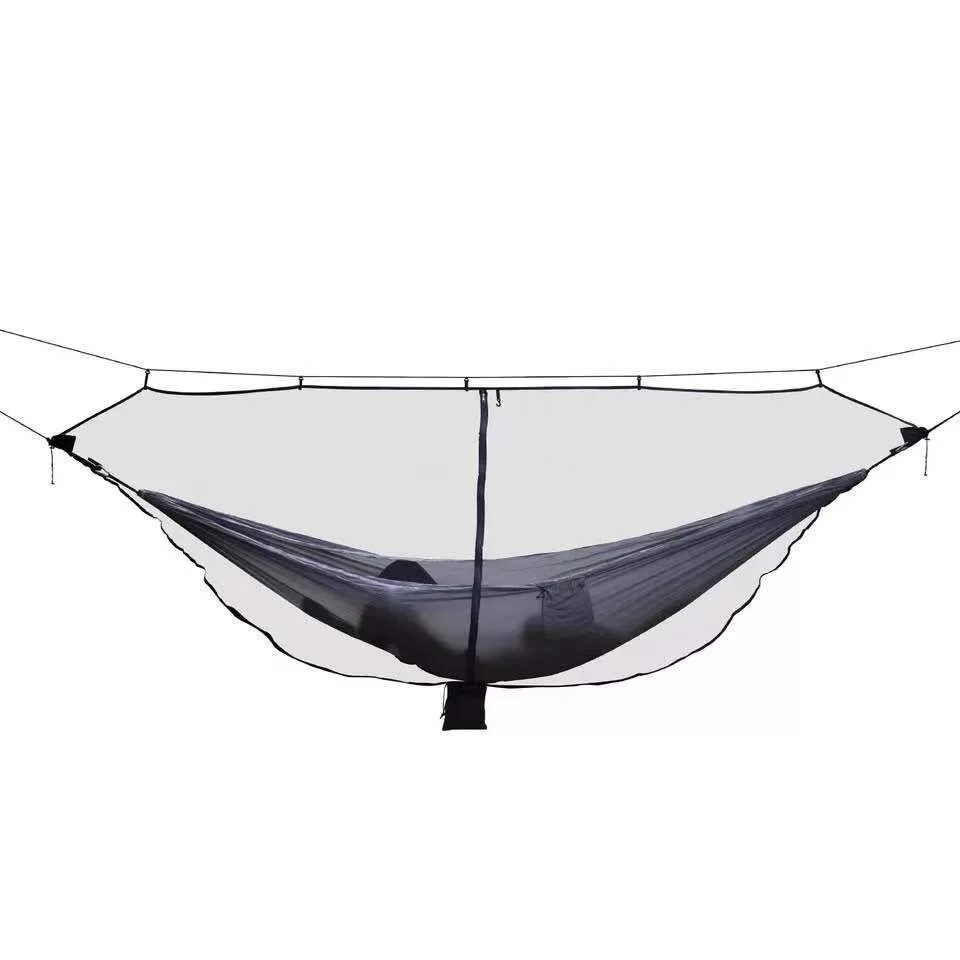
The Science of the 30-Degree Hang Angle
The single most important factor in hammock comfort is achieving the correct hang angle. A 30-degree angle from horizontal creates the ideal “smile” shape that allows proper body positioning without excessive pressure points.
At this angle, the hammock creates a natural curve that, when combined with a diagonal lay, allows your body to lie almost flat with excellent spinal alignment. Too tight (less than 30 degrees), and you’ll create a flat, taut surface that causes shoulder squeeze and calf pressure. Too loose (more than 30 degrees), and you’ll form an exaggerated curve that forces your body into an uncomfortable banana shape.
A simple way to estimate this angle is the “finger gun” method: extend your arm from the attachment point toward the hammock end with your thumb up and index finger pointing along the suspension. If your thumb points straight up (90 degrees) and your finger points along the suspension line, you’ve created approximately a 30-degree angle.
Understanding proper hammock installation requirements and safety guidelines ensures both comfort and security in your setup.
Ridgeline Implementation for Consistent Comfort
A structural ridgeline—a cord running above the hammock from end to end—is the secret weapon for consistently perfect hammock setups. This simple addition:
- Automatically maintains the ideal sag regardless of hang distance
- Provides a consistent lay each time you hang your hammock
- Creates a reference point for accessories like bug nets and gear organizers
- Makes adjustments simpler since only height needs to be modified
The ideal ridgeline length is typically 83% of your hammock’s total length. For an 11-foot hammock, this means a ridgeline of about 9 feet 2 inches. This ratio creates the perfect amount of sag for comfortable diagonal laying.
Suspension Systems That Enhance Comfort and Usability
Your suspension system does more than just hold your hammock—it affects setup ease, tree health, and adjustability:
- Wide tree straps (minimum 1.5 inches/4 cm wide) distribute pressure to protect tree bark and prevent damage
- Daisy chain systems offer multiple attachment points for quick adjustments without retying knots
- Whoopie slings provide lightweight, infinitely adjustable tension control
- Longer suspension (10-15 feet total) gives more flexibility in hang locations
For those looking for complete solutions, camping hammocks with stands eliminate the need to find suitable trees while still allowing you to achieve the perfect hang angle for maximum comfort.
Essential Accessories That Transform Comfort
Conquering “Cold Butt Syndrome” with Proper Insulation
One of the biggest comfort challenges for hammock users is “Cold Butt Syndrome”—the sensation of cold underneath you even in mild temperatures. This occurs because your body weight compresses the insulation in your sleeping bag or the hammock fabric, eliminating the air pockets that provide warmth.
Underquilts solve this problem by hanging beneath your hammock, providing insulation without being compressed by your weight. They come in various temperature ratings and sizes:
- Full-length underquilts cover head to toe for maximum warmth
- 3/4-length versions cover shoulders to knees (where most heat loss occurs) while saving weight
- Summer underquilts provide just enough insulation for mild nights
Alternatively, sleeping pads can provide insulation, though they tend to shift and can be frustrating to position. Look for wider pads (25-30 inches) with non-slip surfaces, or pads with hammock-specific wings to prevent movement.
For top insulation, hammock-specific top quilts offer better freedom of movement than sleeping bags, wrapping around you without compressed insulation underneath.
Weather Protection for Year-Round Comfort
A properly pitched tarp transforms your hammock from fair-weather lounger to all-season shelter. Consider these configurations:
- Diamond tarps provide minimal coverage with maximum ventilation for summer use
- Hexagonal tarps balance protection and visibility
- Rectangular tarps offer maximum coverage for winter conditions
- Doors (flaps at the ends) can be closed for complete weather protection
Setting your tarp at the right height balances protection with airflow. In good weather, position it higher for views and ventilation. During storms, lower the tarp and angle it against prevailing winds.
Don’t forget drip lines—small pieces of cord tied to your suspension that prevent water from running down into your hammock during rain. These simple additions make creating the perfect hammock haven possible even in challenging conditions.
Support Accessories for Ergonomic Comfort
Small accessories can dramatically improve comfort by addressing specific pressure points:
- Small inflatable or stuff-sack pillows support your neck and maintain proper spinal alignment
- Knee pillows (small pillows placed between or under knees) prevent hyperextension
- Foot elevation pillows improve circulation and relieve pressure
- Gear organizers keep essentials within reach, preventing the need to exit the hammock
These seemingly minor additions can transform your experience from merely comfortable to truly luxurious. For those wanting a ready-to-go solution, complete camping hammock systems include many of these comfort-enhancing accessories designed to work together.
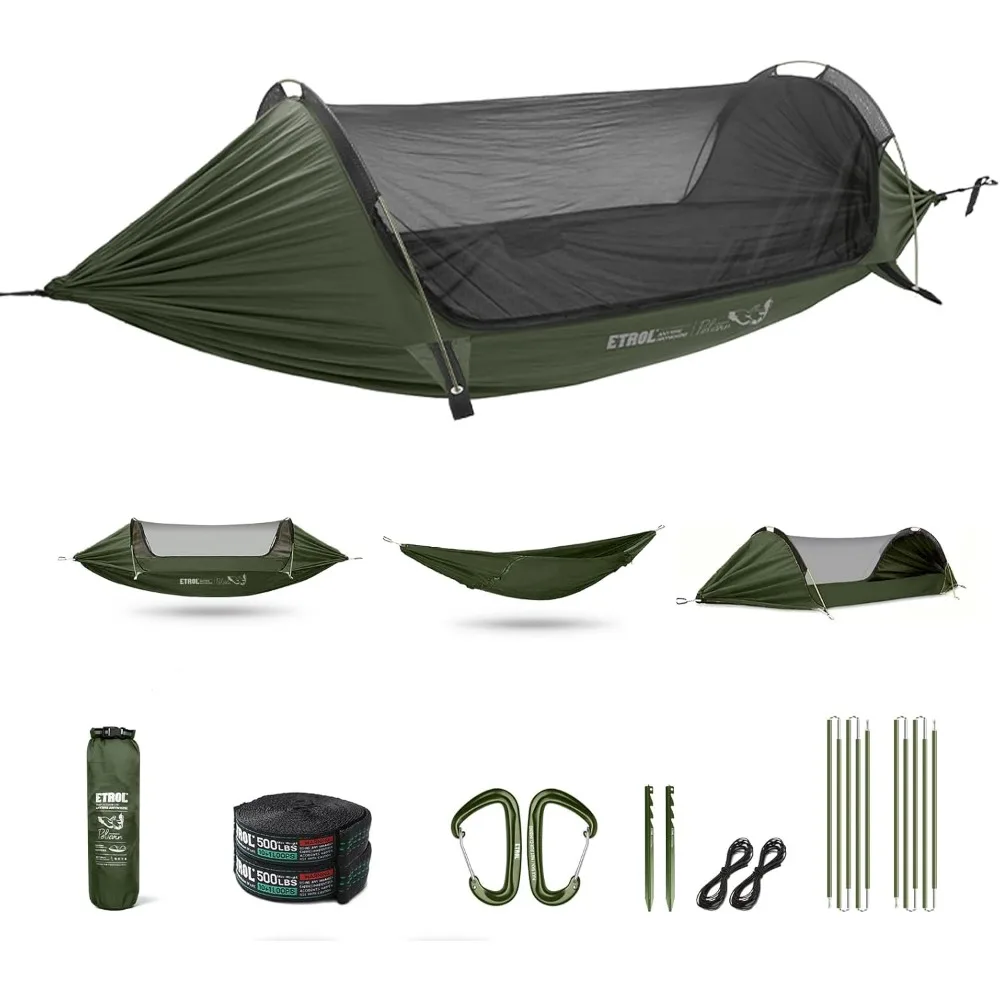
Perfecting Your Lay: Body Positioning Techniques
Mastering the Diagonal Lay Method
The secret to achieving a flat, pressure-free position in a gathered-end hammock is the diagonal lay. This technique transforms the curved hammock into an almost flat surface:
- Enter your hammock and sit in the center
- Slowly lay back while shifting your feet and head toward opposite sides of the hammock
- Position yourself at roughly a 30-degree angle from the centerline
- Adjust until you find the “sweet spot” where your body feels flattest
- Fine-tune by shifting your knees slightly toward the centerline if needed
This positioning distributes your weight across the hammock’s width rather than along its length, creating a remarkably flat surface without pressure points. The diagonal lay works with most hammock designs but is particularly effective in wider hammocks.
When setting up indoors, understanding whether it’s safe to hang a hammock indoors helps ensure you can practice these techniques without structural concerns.
Customizing for Different Sleeping Positions
While hammocks naturally favor back sleeping, you can adapt for different positions:
For side sleepers:
– Use a wider hammock that allows more diagonal positioning
– Place a small pillow or clothing item between your knees
– Increase the hammock’s sag slightly for a flatter surface
– Consider a bridge hammock design, which some side sleepers find more accommodating
For back sleepers:
– Position a small pillow under your neck rather than your head
– Slightly elevate your knees with a small pillow to relieve lower back pressure
– Use a more extreme diagonal position for the flattest lay
Stomach sleeping remains challenging in hammocks, but some users find success by:
– Using an extremely diagonal position
– Placing a firm pillow under the hips to prevent overarching
– Selecting a bridge hammock with a flatter design
A-Frame Stand Hammock Sets, Swinging Hammock Chair Sets
$154.62 Select options This product has multiple variants. The options may be chosen on the product pageCamping Hammock Sets with Bug Net, Ultralight Camping Hammock Sets
$139.72 Select options This product has multiple variants. The options may be chosen on the product pageClassic Wooden Stand Hammock Sets, Heavy Duty Hammock Sets
$1,061.68 Select options This product has multiple variants. The options may be chosen on the product pageHammock Sets with Canopy, Heavy Duty Hammock Sets
$286.31 Select options This product has multiple variants. The options may be chosen on the product pageDouble / Two Person Hammock Sets, Rope Hammock Sets
Double Traditional Cotton Rope Hammock with Extension Chains – 450 lbs Capacity for Backyard & Patio$292.98 Select options This product has multiple variants. The options may be chosen on the product page
Troubleshooting Common Hammock Discomforts
Even experienced hammock users occasionally encounter discomfort. Here are solutions to the most common issues:
Shoulder Squeeze: This uncomfortable pressure on the shoulders occurs when the hammock is hung too tightly or when lying parallel to the centerline.
– Solution: Increase sag in your hammock, perfect your diagonal lay, and ensure your hammock is wide enough for your frame.
Calf Ridge Pressure: The uncomfortable ridge of fabric that presses against your calves when lying in line with the hammock.
– Solution: Master the diagonal lay, use a longer hammock, or place a small pillow under your knees to elevate them above the ridge.
Middle Slide: The frustrating tendency to slide toward the center of the hammock during the night.
– Solution: Perfect your diagonal lay, slightly elevate the foot end of your hammock, or use a hammock with an asymmetric design.
Instability and Tippiness: The feeling that you might flip out of the hammock when shifting position.
– Solution: Hang your hammock lower (18 inches from the ground is ideal for sleeping), widen your attachment points, and practice proper entry/exit techniques.
Entry and Exit Struggles: Difficulty getting in and out gracefully.
– Solution: Sit in the middle of the hammock edge first, then swing your legs in. For exit, reverse the process. Keep your center of gravity over the hammock until the last moment.
Advanced Comfort for Specific Environments
Adapting your hammock setup to different environments maximizes comfort in any condition:
For cold weather:
– Use a four-season tarp with doors that can close completely
– Add a top cover or winter sock that encloses the hammock
– Layer insulation with both an underquilt and a sleeping pad
– Use a hot water bottle inside a sock near your core
For hot weather:
– Choose breathable fabrics like cotton or lightweight nylon
– Increase airflow with a minimal tarp setup or no tarp in clear weather
– Position your hammock in locations with natural shade and breeze
– Use a spreader bar design for maximum ventilation
For indoor use:
– Verify wall or ceiling attachment points can support your weight
– Consider a hammock stand for flexibility without permanent installation
– Use shorter suspension systems to accommodate limited space
Finding the best indoor and outdoor hammock locations can dramatically improve your comfort by optimizing factors like shade, wind protection, and scenic views.
Supplement: Expert-Recommended Complete Hammock Systems
For those wanting pre-configured comfort without the trial and error:
Beginner-Friendly Complete Systems:
– Look for kits including hammock, suspension, bug protection, and rain coverage
– Choose systems with easy-to-understand setup instructions
– Select options with included structural ridgelines
Budget-Friendly Comfort Setups:
– DIY underquilts made from inexpensive synthetic blankets
– Repurposed camping gear (tarps, sleeping pads) adapted for hammock use
– Single-piece suspension systems that eliminate the need for knot knowledge
Premium Maximum Comfort Configurations:
– Down-filled underquilts matched to your local climate
– Lightweight, waterproof silnylon tarps with multiple configuration options
– Custom-length structural ridgelines for your specific body type
– Accessory attachment systems for perfect organization
The perfect setup often includes a reliable foundation, and hammocks with stands provide versatility for both indoor and outdoor use without requiring trees or permanent mounting points.

Safety and Longevity of Your Comfortable Setup
Creating a comfortable hammock setup also means ensuring it’s safe and durable:
- Always hang at a safe height—no more than 18 inches (45 cm) from the ground for sleeping
- Verify all components can support at least 2.5 times your body weight
- Inspect suspension components before each use for fraying or damage
- Wash and properly store hammocks according to their specific material requirements
- Choose tree-friendly straps that won’t damage bark
Regular maintenance extends the life of your comfortable setup:
– Clean fabric according to manufacturer specifications
– Store completely dry to prevent mold and mildew
– Keep synthetic materials out of direct sunlight when not in use
– Periodically check and replace worn suspension components
Following indoor and outdoor hammock safety guidelines ensures your relaxation remains worry-free for years to come.
By implementing the techniques and recommendations in this guide, you’ll transform any hammock from a simple swinging seat into the ultimate relaxation environment. The perfect hammock setup balances science, proper technique, and personal preference to create a truly customized comfort experience that might just replace your bed as your favorite place to rest.

